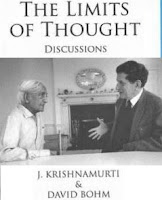Last month I explored the question “Can tradition cause brain damage?” in a blog. The post was based on a dialogue between spiritual teacher Jiddu Krishnamurti and physicist David Bohm in the book “The limits of thought”. My blog ended with a brief mention of how the brain damage could get healed as per the dialogue. In this article, I would like to expand on the healing process as JK-Bohm discuss it in the book.
Can the damage be healed at all? JK says, “If it is
completely damaged, you can’t do anything about it, you are ready for an
asylum. But we are talking of a brain that is not too damaged.”1
What is the first necessity? JK says, “That is the
first necessity, that I realize it.” What do I realize? “That whatever the
damaged brain does, which is the result of thought and tradition and all the rest
of it, will produce further damage.”2
Let me try to explain this part with an example. Let’s say
the cultural tradition says that you must become a successful person otherwise
your life is a waste or success is necessary for a secure future. So, the
thought of becoming successful dominates my life. It involves identifying success
parameters like wealth, position, fame, social contribution, etc. And I get
caught in the measurement game. I constantly compare what I have (wealth, name,
fame) with some gold standard of success, find something that is still missing and
strive to get there.
We can extend this to religious tradition as well. JK says, “I have accumulated psychologically as a Hindu; another has accumulated as a Muslim; there are thousands of divisions. Therefore, accumulation in its very nature divides people, and therefore creates conflict.”3
What JK is saying is that the first step is to realize that my thought process is caught in a loop that is the result of the tradition-induced brain damage and it is making the damage worse. The next thing that may happen is a deep insight which “acts as a tremendous shock or jolt”4 to the brain.
Deep insight into the movement of thought: JK says, “If I have an insight into the whole nature of control, which is measure, that liberates the mind from the burden.”5 “When there is this insight, the damage is undon.”6 However, JK warns, “It (the insight) cannot be invited. It’s like saying – I’ll be attentive in order to receive truth. That’s nonsense.”7
Now, insights are not new to us. When there is a shift of
perception while looking at an optical illusion, it is an example of a tiny
insight. Many of us also experience a small jolt when we realize a belief, we
held for a long time is false. For example, Santa Clause is a fiction, or
ghosts don’t exist. Could a deep insight JK is talking about bring a
significant change in the brain? Yes, it is possible. Unfortunately, there is no
formula or method for getting the insight.
Don’t be concerned with truth: Should I strive for such a deep insight into truth? JK says, “Don’t be concerned with truth, you don’t know what it means. Be concerned only with (thought-created) reality and its distortions. To be free of distortions, just observe the distortions, don’t resist them, just observe them. That observation needs (attentional) freedom and that freedom and the observation will give you energy to push away the distortions.”8 A distortion typically manifests as a disturbance such as fear, anxiety, stress, anger, blame, guilt, etc.
To summarize, we need attentional freedom to watch the movement of thought. It is important to observe the movement especially when there is a disturbance in the form of fear, anxiety, anger, etc. This observation may cultivate the ground for a deep insight to sprout into the meaninglessness of the whole nature of control and measurement thought is caught up in. The deep insight would heal the brain. There is no formula or method for the insight.
Source:
1.
“The limits of thought”, J. Krishnamurti and
David Bohm, Krishnamurti Foundation India, 2013, page 94.
2.
“Limits of thought”, Page 94
3.
“Limits of thought”, Page 123
4.
“Limits of thought”, Page 94
5.
“Limits of thought”, Page 106
6.
“Limits of thought”, Page 108
7.
“Limits of thought”, Page 52
8. “Limits of thought”, Page 26



